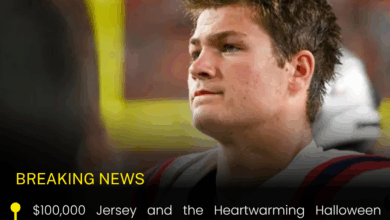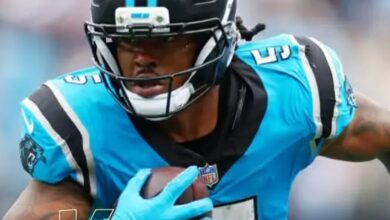HH. A Minnesota Vikings fan who was forced to sell his season tickets to pay for treatment broke down in tears when he discovered that the team would cover all of his medical costs and give him free access for the next five seasons. A Vikings spokesperson said: “In our purple family, no one fights alone.”
A Purple Story in the Heart of Winter
It was one of those cold Minneapolis mornings where the sky hangs low and gray over the Mississippi River — the kind of day when even the city’s most loyal fans huddle indoors, waiting for spring and football season to come again. But this time, the warmth didn’t come from a kickoff. It came from an act of compassion so powerful that it left an entire state in tears.
In the heart of Minnesota, a lifelong Vikings fan — known among locals simply as “Dave from Section 128” — found himself fighting the toughest battle of his life. For years, Dave had been a fixture at U.S. Bank Stadium, his voice one of the many that turned the stands into a thunderous sea of purple and gold. But last season, that roar faded for him. When a serious illness forced him to sell his season tickets to pay for treatment, he believed his days of standing shoulder to shoulder with his fellow fans were over.
A Call That Changed Everything
It happened on an ordinary Tuesday. Dave was at home, sorting through medical bills, when his phone buzzed with a private number. Expecting another call from the hospital, he answered with the weariness of someone used to bad news. But this time, the voice on the other end carried something different — warmth, compassion, and the unmistakable tone of a community reaching back to one of its own.
“Hi Dave,” the voice said. “This is Sarah calling from the Minnesota Vikings front office. We’ve been following your story. And the team wanted me to tell you personally — you’re not alone in this fight.”
For a moment, silence. Then came the words that would shake Minnesota’s football world.
“The Vikings organization has decided to cover all of your medical expenses and grant you free access to every home game for the next five seasons.”
Dave’s hands trembled. He tried to speak, but only managed a whisper — “Are you serious?”
The caller smiled through the line. “In our purple family,” she said, “no one fights alone.”

The Reaction Heard Across the North
Word spread like wildfire through local radio shows, fan forums, and social media. By evening, the story had taken over Minneapolis headlines. Local news anchors struggled to keep their composure as they replayed footage of Dave’s emotional reaction — his tears falling as he clutched his worn-out Fran Tarkenton jersey, the one he’d worn for over thirty years.
Within hours, #PurpleFamily began trending nationwide. Messages poured in from fans across the NFL — from Green Bay to Buffalo — each echoing the same sentiment: This is what sports are supposed to be.
The Vikings’ official account posted a single photo: the team’s logo, overlaid with six simple words —
“In our purple family, no one fights alone.”
It was retweeted hundreds of thousands of times, shared by current and former players, celebrities, and even rival teams. It became more than a slogan. It became a statement about what loyalty means in a world where people often feel disposable.
The Meaning Behind the Purple
The Minnesota Vikings, one of the NFL’s most storied franchises, are no strangers to heartbreak — four Super Bowl appearances, no championships, decades of near-misses and shattered dreams. Yet their fanbase remains one of the league’s most fiercely loyal. They call themselves the “Skol Nation,” and they don’t just show up on Sundays — they live and breathe purple.
That’s why this act of compassion resonated so deeply. For the team to reach out to one of their own — not for publicity, but for humanity — reaffirmed everything Vikings fans believe about their identity.
Head coach Kevin O’Connell was asked about the decision at a press conference. His response was quiet but firm:
“We talk all the time about being a family. That word means something here. It means standing up for one another — on and off the field.”
It wasn’t a corporate gesture. It was a promise kept.
A Stadium That Became a Sanctuary
When Dave finally returned to U.S. Bank Stadium, it was during a late-season home game against the Chicago Bears. The stands were packed, the air electric. But when his face appeared on the Jumbotron, the energy changed — the entire stadium rose to its feet.
He stood there, overwhelmed, tears streaming as tens of thousands chanted his name. Then came the chant that would echo through the dome and across the state:
“NO ONE FIGHTS ALONE! NO ONE FIGHTS ALONE!”
Even players on the field stopped and looked up, applauding. Vikings quarterback J.J. McCarthy, the team’s young star, pointed toward Dave’s section, then tapped his heart twice — a silent acknowledgment that football is bigger than points or playoffs.
In that moment, U.S. Bank Stadium felt less like an arena and more like a cathedral — a place where community, compassion, and courage intertwined.
Why This Story Matters
In an era when professional sports can sometimes feel dominated by business deals, endorsements, and social media drama, the Vikings’ gesture stood out as something rare — pure humanity. It wasn’t about selling tickets or chasing headlines. It was about honoring the invisible bond between a team and its fans.
Sociologists have often written about sports as a “modern religion,” where stadiums serve as temples and players as heroes. But at the heart of it, what makes fandom powerful isn’t worship — it’s connection. It’s the belief that you belong somewhere, that when life knocks you down, someone — or some team — will be there to help you back up.
And that’s what the Vikings did. They turned words into action. They proved that their motto — “In our purple family, no one fights alone” — wasn’t a marketing line. It was a mission.
The Ripple Effect
After the story broke, something extraordinary happened. Fans across the country began writing to their teams, urging them to establish similar “fan care programs” — funds dedicated to helping loyal supporters in crisis. The movement, inspired by what Minnesota did, is already being discussed by community boards within several NFL franchises.

Meanwhile, Vikings fans have begun organizing annual blood drives and cancer support fundraisers under the banner “Skol Strong.” The idea: to make compassion part of the Vikings’ culture, not just a one-time act of generosity.
Dave, for his part, remains humble about the attention. “I didn’t do anything special,” he said in a local interview. “I just loved my team. And they loved me back.”
Football, Faith, and Family
Minnesota’s winters are long and hard. The snow can bury streets, freeze rivers, and test patience — but it can’t freeze the spirit of its people. That’s why this story hit home. It wasn’t just about one man’s struggle; it was about every Minnesotan who’s ever faced hardship and leaned on their community to endure.
For the Vikings, this wasn’t charity — it was kinship. It was about upholding the values that built the franchise: resilience, loyalty, and faith in something bigger than yourself.
When asked what he plans to do with his new five-season pass, Dave laughed softly. “I’m going to bring my son. He’s 10. I want him to see what family really looks like — not the kind you’re born into, but the kind that chooses you.”
A Final Thought
As the season goes on, the story of “Dave from Section 128” continues to echo beyond the boundaries of football. It’s retold at family dinners, at tailgates, in classrooms — a story of what happens when humanity triumphs over indifference.
And somewhere in the purple glow of U.S. Bank Stadium, there’s a man standing tall, wrapped in his old Vikings jersey, feeling the crowd’s energy rise around him — the same crowd that once cheered for touchdowns, now cheering for something far greater: the unbreakable bond of belonging.
Because in Minnesota, loyalty isn’t about wins and losses. It’s about showing up for one another.
And thanks to one team’s act of compassion, the world now knows what the Vikings’ motto truly means.
“In our purple family,” the spokesperson said, “no one fights alone.”
Not in Minnesota. Not ever.

